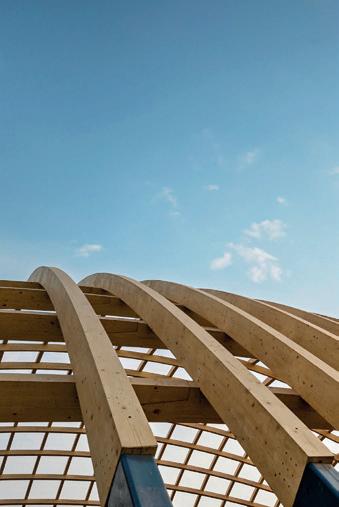CHAMPIONS OF WOOD



UL Design No. V314, the first ASTM E119 (UL 263) fire-retardant-treated lumber and plywood 2-Hour bearing wall assembly.

UL System No. EWS0045, the first NFPA 285 fire-retardant-treated lumber and plywood exterior wall system demonstrating compliance with IBC Section 1402.5.
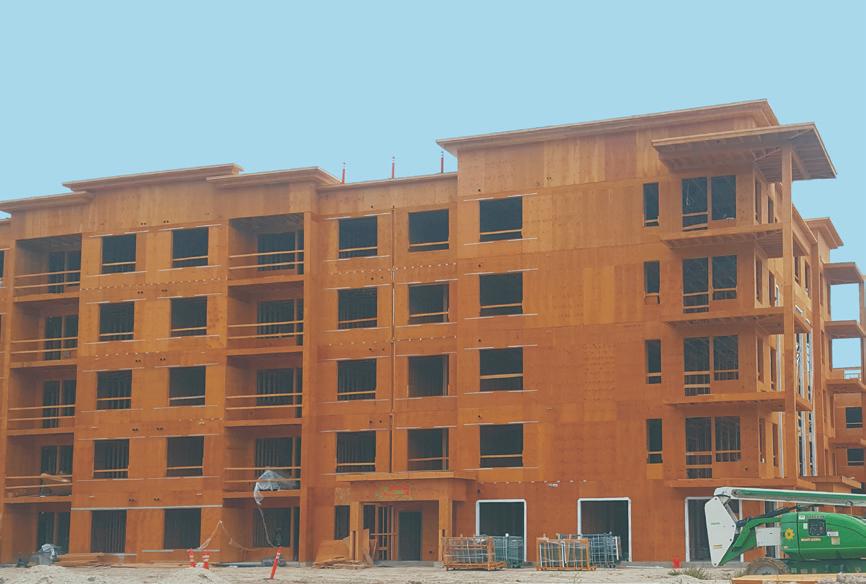
Leading the way. Learn more at frtw.com
For technical assistance: 1-800-TEC-WOOD
Based on UL Design No. V314, UL System No. EWS0045 requires UL Classified Pyro-Guard® fire-retardant-treated lumber and plywood.The Modular Unit (MU50) 26
A project on oceanside cliffs in Turkey wins a 2019 Wood Design & Building Award (Honor).
2019 Wood Design & Building Award Winners 12
Wood Design & Building recognizes excellence, innovation and creativity in a wide range of wood projects

Cardinal House 30
Against the Grain 6 Artful staircases
Wood Chips 8 Projects to watch and recent news
Wood Ware 46
Foon Skis uses local B.C. wood for handcrafted custom skis
Douglas Cardinal presents a modular, mass timber solution to address the housing crisis
Ten architects who are wood champions, including some of their best projects
Sansin answers some of the most common questions about architectural finishes for wood

This was my second year observing the Wood Design & Building Award jury deliberations, and it was an event I eagerly anticipated for months. The process is especially fascinating because each awards cycle is unique, with a different jury reviewing projects from almost every corner of the world. Once again, our jurors were both humbled and inspired by the overall quality of work; we highlight the Wood Design & Building Award winners starting on p.12, with a feature about the cover project, a modular structure in Turkey, on p.26.
Although it didn’t win an award, one of the submitted projects that truly inspired me is the Cardinal House (p.30). Many of us have witnessed the derelict state of housing on First Nations reserves, and this project by Douglas Cardinal seeks to help solve those challenges with an elegant, affordable and innovative mass timber prototype. In honor of this initiative, “Inspiration Board” (opposite) also is dedicated to some of the other buildings in Canada that illustrate the powerful aesthetic of modern Indigenous design. Naturally, the use of wood is integral.
Building with wood is, in fact, as old as time. Recent research published in PLOS ONE revealed that the ancient Romans relied on long-distance timber trading to construct their empire; oak planks forming part of a Roman portico originated in the mountains of eastern France, and were harvested sometime between 40 and 60 CE.
But even with the lengthy history of wood architecture, we’re constantly finding new ways to use this ancient material. “Innovators & Gamechangers” (p.34) looks at 10 firms that have been leading the way, and “Projects to Watch” (p.8) provides an overview of several exciting proposals – from the tallest mass timber office building in North America to the largest wooden building in the world (not surprisingly, in the Netherlands).
Clearly, this decade is shaping up to be an exciting time for mass timber, but there aren’t enough pages in this magazine to include all of the designers and projects that we wanted to mention, so with each future issue of Wood Design & Building, we’ll continue sharing the innovators and gamechangers that are leading us into a new era of wood architecture.
Popi Bowman Managing Editor
Wood Design & Building magazine invites you to submit your project for consideration and possible publication. We welcome contributed projects, bylined articles and letters to the editor, as well as comments or suggestions for improving our magazine. Please send your submissions to pbowman@dvtail.com.

sponsored by
Along with the Cardinal House featured in this issue (p.30), several recent Canadian projects artfully showcase First Nations design principles.
www.WoodDesignandBuilding.com
Winter 2019-20, Volume 20, Issue 84
PUBLISHER ETIENNE LALON DE elalonde@cwc.ca
DIRECTOR, COMMUNICATIONS, NATALIE TARINI EVENTS AND MEMBER SERVICES ntarini@ cwc.ca
SENIOR MANAGER, SPECIAL PROJECTS IOANA LAZEA ilazea@cwc.ca
MANAGING EDITOR POPI BOWMAN pbowman@dvtail.com
CONTRIBUTORS MITCHELL BROWN SARAH HICKS
ART DIRECTOR SHARON MACINTOSH smacintosh@dvtail.com
ADVERTISING SALES
SALES MANAGER BETH KU KKONEN bkukkonen@dvtail.com 905.886.6641 ext. 306
SENIOR ACCOUNT EXECUTIVE DINAH QUATTRIN dquattrin@dvtail.com 905.886.6641 ext. 308
V.P. PRODUCTION SERVICES ROBERTA DICK robertad@dvtail.com
PRODUCTIO N COORDINATOR CRYSTAL HIMES chimes@dvtail.com
In the Yukon, the Carcross Learning Centre by Kobayashi + Zedda is designed using sustainable materials, including photovoltaics and a green roof. Totem poles and heavy timber construction reflect the coastal heritage of the Carcross-Tagish First Nation.
DOVETAIL COMMUNICATIONS PRESIDENT SUSAN A. BROWNE sbrowne@dvtail.com
EDITORIAL BOARD
Shelley Craig, Principal, Urban Arts Architecture, Vancouver, BC Gerry Epp, President & Chief Engineer, StructureCraft Builders Inc., Vancouver, BC Laura Hartman, Principal, Fernau & Hartman Architects, Berkeley, CA
Randall Kober, Master Lecturer, Faculty of Architecture, Laurentian University, Sudbury, ON CIRCULATION
PUBLICATION PARTNERS wdesign@publicationpartners.com
SUBSCRIPTIONS
Three issues per year for $24.00, two years for $40.00, and three years for $50.00. Please call toll-free 1.866.559.WOOD or visit our website to subscribe. Subscription inquiries and customer service:
The Odeyto Indigenous Centre at Seneca College in Ontario was designed by Gow Hastings Architects in collaboration with Two Row Architect (an Indigenous-owned firm). The structure was inspired by the image of a canoe pulling up to a dock; curved glulam roof beams and tongue-and-groove decking are exposed to create a warm ambiance.

1.866.559.WOOD or email wdesign@publicationpartners.com
Send address changes to:
PUBLICATION PARTNERS
Garth Atkinson
1025 Rouge Valley Dr., Pickering, ON Canada L1V 4N8
Published by:
DOVETAIL COMM UNICATIONS INC
30 East Beaver Creek Rd., Suite 202, Richmond Hill, ON Canada L4B 1J2 905.886.6640 Toll-free 1.888.232.2881 www.dvtail.com
For:
CANADIAN WOOD COUNCIL
99 Bank St., Suite 400, Ottawa, ON Canada K1P 6B9 1.800.463.5091 www.cwc.ca
www.WoodDesignandBuilding.com www.WoodDesignAwards.com
ISSN 1206-677X
Copyright by Canadian Wood Council. All rights reserved. Contents may not be reprinted or reproduced without written permission. Views expressed herein are those of the authors exclusively.
Publication Mail Agreement #40063877
Printed on recycled paper
One of the Sustainable Forestry Initiative Sponsorship Award winners in 2019, and also the Sansin Award recipient, the Tsleil Waututh Administration and Health Centre in North Vancouver, B.C., was designed by Lubor Trubka Associates Architects (LTA). The main roof structure features NLT spruce-pine-fir panels supported on Douglas fir glulam beams. This is one of many First Nations projects the firm has completed, and LTA is a long-time advocate for wood architecture.

Printed in Canada

Where would we be without staircases? Stuck on the ground floor, yes, that much is clear. But for all the functionality they offer in even the simplest projects, most of us tend to think of these essential structures as a means to get somewhere else, rather than as a destination unto themselves. On the other hand, staircases – by virtue of being structural elements that most people have to use – offer designers the opportunity to play with form, draw attention to architectural details and bring all the elements of a common space together. And when designers take that opportunity, the results can often be... uplifting.
LVMH Media Division, Paris, France: French designer Ora Ïto created this staircase that twists up the Paris offices for LVMH, the parent company of luxury brands including Louis Vuitton and Dior. The staircase snakes up four storeys, comprising 429 wooden battens that cradle the underside of the stair and form the handrails on either side. Curved edges detail each of the slats; when placed side by side, they form wave-like indents across the stair. There is also a semi-circular indent on the inner side of the slats that forms a nook for the steel handrail, while LED lights illuminate the undersides of the stair treads. “I wanted the staircase to be the centerpiece of the building,” Ïto said. “This creature undulates in the space, shaping and pervading it.”
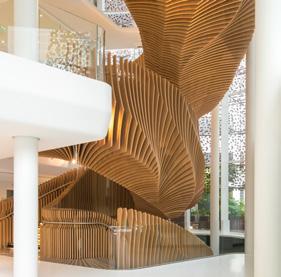
Abercrombie Business School, Sydney, Australia: The nondescript name of “Atrium Stair No. 4” belies the intricacy of this five-level spiraling staircase in a business school building designed by Woods Bagot. When asked to install the staircase’s external cladding, the designer initially manufactured a prototype of 10 stairs and a landing section that was fully clad in the finished panels, showing all joint details, panel finishes, colors, lighting details and shadow line dimensions. A major challenge was ensuring that a consistent curve in three dimensions was achieved across all levels; the prototype was measured using a 3D scanner to determine how the design intent could be achieved. Silky oak timber veneer cladding forms the external faces of the stair, with LED lighting installed to the top of the inside balustrade.

Lewisham Residence, London, UK: An ash-wood staircase perforated with circular holes connects the two storeys of an Edwardian house that was given an extension to create more space for the living, kitchen and dining areas at the ground-floor level, and new bedrooms above. Vertical timber batons cover the exterior of the new structure, with a thin gap of shadow defining the horizontal split between the two storeys; a full-height banister of ash wood with circular holes punched through it lines the open side of the stairway connecting these two floors. “The stairs are treated as a piece of habitable furniture, with partial views in and out,” said R2 Studio Architects. “The hole pattern follows the stair profile and includes larger holes along the eye level of both small children and adults.”
Frithville Residence, London, UK: As part of a project that saw the refurbishment and remodeling of a house in West London, WG+P Architects was given the task of developing a striking modern staircase to access the newly formed mansard accommodation. The solution was to design the stair as a kit of parts fabricated off-site from TinTab plywood sheets and pieced together in situ, resulting in an abstract, dynamic timber stair to contrast the traditional stair and balustrade of the flights below. As the firm explains on its website, “Stairs are a particularly important structural building element, with a close experiential/ tactile relationship with building users in achieving vertical circulation, and visually as an object within space. Stairs should be expressive of function and the process that makes them, and in our opinion decorated by that process and appropriate to context.”









Heightened interest in mass timber construction has resulted in an impressive, ever-growing list of upcoming projects around the world. These are just a few of those we’ll be watching closely over the next several years:
The Danish firm will be constructing a 10-storey timber office building –possibly the tallest in North America – in Toronto. Occupancy is expected in late 2021.
This will be Toronto’s first NLT building, a hybrid of timber, concrete and steel. With seven storeys, it also aims to become Canada’s tallest mass timber commercial structure.
As part of a $3.5-billion, 28-acre development on the San Francisco waterfront, another project that aims to be the largest mass timber office building in North America (at six storeys tall and 310,000 sq.ft.) is expected to be completed in 2021.

Walmart Headquarters by Gensler with Fast

A 350-acre office campus in Arkansas will feature more than 2 million sq.ft. of mass timber construction, with completion in phases between 2020 and 2024.
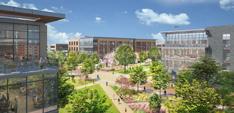
A proposal to build a CLT-hybrid, 340,000-sq.ft. mixed-use tower up to 40 storeys tall in Vancouver was announced last spring; there were no further updates as of press time.

An $8-billion, 9.2-million-sq.ft. development in California will feature numerous mass timber structures on 240 acres. Construction starts this year, with the first phase scheduled to open in 2023.



This design proposal is for an 18-storey residential tower constructed of prefab modular CLT panels, with abundant patio garden spaces to create a tower of greenery; plans for construction have not been announced.
Penda co-founder Chris Precht also proposed The Farmhouse, a modular mass timber high-rise concept with integrated greenhouses.
k
In Vancouver, social housing and commercial space will be housed in a 17-storey mass timber building that is aiming for Passive House certification.


Possibly the largest wooden building in the world – two connected towers – is being planned in Eindhoven, the Netherlands. A construction timeline has not been released.


Allas
In 2016, the first Allas Sea Pool opened on the waterfront in Helsinki. An open competition recently invited proposals for a design that could be implemented anywhere, and OOPEAA’s design for a modular CLT structure was the winner. The developer plans to build these outdoor pools internationally, starting with the next one in Oulu, Finland (expected to open in early 2021).

W350
A 70-storey, 1,148-ft.-tall hybrid mass timber skyscraper is being planned in Tokyo, to celebrate the 350th anniversary of Sumitomo Forestry in 2041 (the anticipated completion date).
Oakwood Timber Tower 2 by PLP Architecture with Cambridge University
A concept for London’s first timber skyscraper, the Oakwood Timber Tower, was revealed by this firm in 2016; a similar design, with a basketweave-style glulam facade, will be built in the Netherlands and aims to become the world’s tallest timber tower, at 426 feet tall. A construction timeline has not been announced.
Katerra, in partnership with Wallace Properties, recently proposed a 16-storey, 165-unit mass timber tower that would become Washington State’s tallest, totaling about 19,300 sq.ft.
At the end of March, final approval will be voted on for Sidewalk Toronto’s project proposal, a waterfront mass timber neighborhood with 12 buildings ranging from three to more than 30 storeys tall. Snøhetta, Michael Green Architecture and Heatherwick Studio developed the initial design concepts.

The Ramada Hotel is proposing a 12-storey CLT tower expected to begin construction this summer.
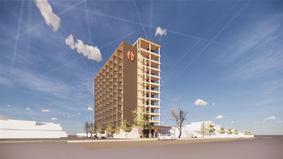

New Land Enterprises is planning to build a 23-storey, 231-unit mass timber residential tower designed by Korb + Associates Architects, with a start date this spring and completion expected within two years.
In addition to the Pier 70 project by Hacker Architects, two other mass timber buildings are underway in this city – the four-storey hybrid One De Haro (designed by Peter Pfau of Perkins and Will) is expected to be completed this year, and California College of the Arts plans to break ground this spring to construct several mass timber structures (shown) totaling 90,000 sq.ft., designed by Studio Gang.

Shifting Nests is a new non-profit concept that aims to help solve the housing crisis by creating sustainable, prefabricated tiny homes made primarily of plywood, along with hydroponic systems to encourage the development of community gardens. The design by Vancouver-based Bla Design Group won first prize in the inaugural competition launched by Bee Breeders, which seeks innovative ideas for small projects that can create affordable housing; eligible designs were limited to a maximum size of 270 sq.ft. bladesigngroup.com; beebreeders.com

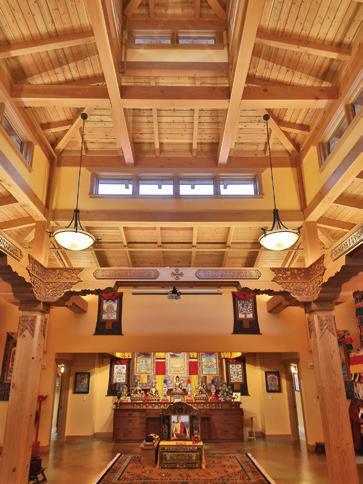
In December, the first project of its kind in Toronto – a fourstorey, heritage restoration/expansion utilizing mass timber – opened to its first occupant, the Shoppers Drug Mart Flagship Store. Designed by Brook McIlroy, with an 1880s facade restoration by ERA Architects and two new frontages, the building at the corner of Yonge and Charles Streets was the first mass timber project to be approved by the City of Toronto when construction started in 2016. “As with any new technology, there were many challenges in establishing the appropriate approvals and building frameworks,” the firm admits. Elevator shafts and stairways are wood, along with other interior and structural elements; the floors are CLT, while columns and beams are glulam. Blackwell Engineers consulted in the design of the mass timber structure. brookmcilroy.com
A student dormitory in Helsinki, this 14-storey, 117-unit mass timber building is the country’s first of its kind; in late 2019, it won Finland’s yearly Wood Award. Designed by Arcadia Oy Arkkitehtitoimisto in collaboration with architect SAFA Samuli Sallinen, the building uses more than 70,600 cu.ft. of wood products, including CLT floors and LVL walls, with a steel-reinforced structure. arcadia.fi
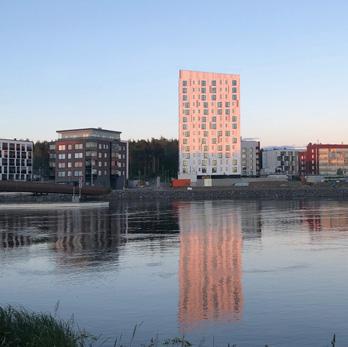
We are pleased to announce the recipients of the 2019 Wood Design & Building Awards. In a process that protects the architect names to eliminate bias, our jurors review every entry (this year, almost 150 projects) and rate them independently; once all reviews are complete, those which are highest rated by at least one juror are discussed among the three architects during a full day of final evaluations. This year, our esteemed jurors – all well versed in working with wood – debated some of the practical details and design challenges that the various projects represented, either well or otherwise. Aesthetics, process and practicality are considered, along with innovation and overall execution.
Each year, many familiar names enter the fray; among those projects that were considered in this session, some of the world’s most famous architects were side-by-side with new and often obscure firms. A combination of design mastery, originality and unique detail consistently distinguished the jurors’ favorites, although they found it difficult to eliminate many of those which didn’t make it onto this list. At the end of the session, they were confident in their choices. The jurors had these comments to share:
“I was impressed and struck by the high quality of the entries in this field, with the international contingent certainly holding up well. The width and breadth of the quality of the submissions, both internationally and across North America, holds well for where we are with wood design. The future looks extraordinary for wood. Spectacular, inspiring – wood is good!” — Russell Acton, principal at Acton Ostry Architects (designers of Brock Commons Tallwood House, winner of many awards, including the inaugural International Prize for Wood Architecture in 2018)
“It was great to see a variety of building types in the submissions, and across those we can see the different kinds of challenges that the architects and teams are confronting as they try to bring large-scale or mass timber use into these different building types. I think people respond well to wood buildings simply because of the warmth and that natural connection, but a lot of these projects found ways to extend that even further, to take advantage of the properties, and the aging and changing of wood over time, to let an element of time enter the buildings inventively. I think it’s very exciting that there continue to be new ways to think about this material that seems so familiar.” — Samuel Lasky,
principal at William Rawn Associates, Architects (a firm with 50 award-winning projects, including the Seiji Ozawa Hall at Tanglewood, which won two AIA National Honor awards)



“The range of scale and in uses of wood, whether it’s being used structurally, whether it’s the envelope – the exploration of different ways wood is used whether it’s shingle, wood siding, panelized – there are lots of interesting variations. And then, the meticulousness of detailing, whether it’s fairly complicated, exotic detailing or whether it’s very elemental, simple, straightforward detailing – there’s a really interesting set of clever solutions and there are some really exquisite examples of the use of wood. But I think beyond the use of wood, the caliber of entries in this awards program is unusually high – and it usually is. It’s been a pleasure to look at this wonderful work – it’s just really high-level architecture, and it’s also very elegant and inventive use of wood.” — Laura Hartman, principal at Fernau + Hartman Architects (founded in 1980 and winners of many wood awards, with an interest in sustainable design since its earliest projects)
Special awards also were granted by the Canadian Wood Council and the event sponsors, Western Red Cedar, SFI and Sansin. In partnership with the Canadian Wood Council, we would like to thank everyone who participated in the 2019 Wood Design & Building Awards program, with special thanks to our three jurors. Congratulations to the winners!
Adohi Hall, University of Arkansas
Fayetteville, AR
Leers Weinzapfel Associates with modus studio, Mackey Mitchell Architects and OLIN
Trades Training Centre, Northern Lights College
Dawson Creek, BC
McFarland Marceau Architects Ltd.
Prospect/Refuge 3
Margaree Forks, NS
Group of students from Dalhousie University, Faculty of Architecture and Planning, led by Talbot Sweetapple of MacKay-Lyons Sweetapple Architects Ltd.
Mirror Point Cottage
Annapolis Royal, NS
MacKay-Lyons Sweetapple Architects Ltd.
Capilano Library
Edmonton, AB
Patkau Architects with Group2
Kiht’han
Sagaponack, NY
Bates Masi + Architects
Sagg Farm
Sagaponack, NY
Bates Masi + Architects
Upper Skeena Recreation Centre
Hazelton, BC
Hemsworth Architecture
Wilson School of Design, Kwantlen Polytechnic University
Richmond, BC
KPMB Architects with PUBLIC Architecture + Communication
Wuehrer House
East Hampton, NY
Jerome Engelking
80 Atlantic
Toronto, ON
Quadrangle
Alexander Court
Washington, DC
Pelli Clarke Pelli Architects with FOX Architects
Forest Hill Pavilion
Toronto, ON
Amantea Architects
Lewis & Clark College Pedestrian Bridge
Portland, OR
Minarik Architecture
Redfox Commons
Portland, OR
LEVER Architecture
Rocky Ridge Boardwalk
Calgary, AB
GEC Architecture
The Modular Unit (MU50)
Izmir, Turkey
Teke Architects Office
Wooden Roof
London, UK
Tsuruta Architects
Trumpf Day-Care Center
Ditzigen, Germany
Barkow Leibinger
Woody – Office Building for Santé publique France, Saint-Maurice, France, Atelier du Pont
Saint-Maurice, France
Atelier de Pont
CANADIAN WOOD COUNCIL AWARDS
Banff Elementary School
Banff, AB
GEC Architecture
Bigwin Island Club Cabins
Baysville, ON
MacKay-Lyons Sweetapple Architects Ltd.
Boundary Bay Fire Hall & Training Centre
Delta, BC
Johnston Davidson Architecture
North Surrey Sports & Ice Complex
Surrey, BC
Francl Architecture
Red Deer College Student Residence
Red Deer, AB
Manasc Isaac Architects
SUSTAINABLE FORESTRY INITIATIVE –SPONSORSHIP AWARDS
Tsleil Waututh Administration and Health Centre
North Vancouver, BC
Lubor Trubka Associates Architects
Upper Skeena Recreation Centre
Hazelton, BC
Hemsworth Architecture
WESTERN RED CEDAR –SPONSORSHIP AWARD
ADK Camp
Horicon, NY
Birdseye
SANSIN – SPONSORSHIP AWARD
Tsleil Waututh Administration and Health Centre
North Vancouver, BC
Lubor Trubka Associates Architects
As we celebrate the architects who are elevating the use of wood, we’re also excited to welcome some new names to the list of Wood Design & Building Award winners. The feature about our cover star, The Modular Unit, can be found on p.26.
Leers Weinzapfel Associates; modus studio; Mackey Mitchell and OLIN
Boston, MA; Fayetteville, AR; St. Louis, MO; Philadelphia, PA
The nation’s largest mass timber building – and the first large-scale, mass-timber student housing – Adohi Hall opened to students this fall at the University of Arkansas. The 708-bed complex displays a pioneering use of CLT and an innovative approach to live-learn communities, with embedded arts and academic spaces fostering student collaboration and interactive learning.
An emphasis on access to nature resonates throughout the project. The housing group is a serpentine band of student rooms that defines three interconnected courtyard spaces, each with a distinctive character. Undulating landforms, rock outcroppings and drifts of native planting extend the vernacular of the nearby Oak Ridge Trail down into the project area, creating a landscape ecology reminiscent of the native Ozark Plateau of northwest Arkansas.
The significant use of wood as the main structural material advances sustainable design by taking advantage of its inherent green properties. Both the CLT floor slabs and the glulam structural frame are sustainably sourced (FSC) European spruce-pine-fir. Locally harvested and milled Arkansas cypress is used extensively throughout the building as a finish material in major public spaces. On the exterior, the cypress cladding highlights points of entry. Used only in weather-protected areas, the exterior cypress is finished with a light transparent stain. Salvaged wood – both three-ply CLT skids from the transport process and mature trees removed during site preparation – was preserved and incorporated into custom tables and benches.
Each floor provides a variety of living configurations, offering students the choice of semi-suite (double rooms
with private bath) or pod (six to eight double rooms clustered around a shared bath and common room). The typical room modules were developed to allow for cost-effective layout of modular CLT panels and glulam framework, and the five storeys above-grade/podium of the Adohi Hall complex maximize the building height and envelope permitted in Type IIIB construction.
The warmth of the project’s exposed structural wood ceilings is apparent in each student room, the study rooms, floor lounges and ground floor common spaces, while wood columns bring the beauty of the material within reach for all. The “cabin” also includes a wood ceiling and trusses that span the full width of the lounge spaces. Indeed, from top to bottom, the structure lives up to its name: “Adohi,” a Cherokee phrase meaning “coming into the forest.”
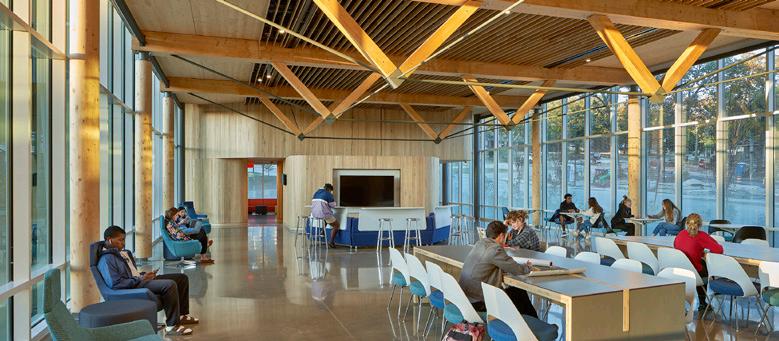
CLIENT
University of Arkansas
Fayetteville, AR
STRUCTURAL ENGINEERS
Equilibrium Consulting Inc.
Vancouver, BC
Engineering Consultants Inc.
Little Rock, AR
GENERAL CONTRACTOR
Nabholz
Rogers, AR
PHOTOGRAPHY
Timothy Hursley
New York, NY



McFarland Marceau Architects Ltd.
Vancouver, BC
Located at the start of the Alaska Highway in northeastern British Columbia, Dawson Creek is a town of 13,000 people where the summers are brief and dry and the winters are severe, with temperatures that regularly dip to -40˚C. The town’s Northern Lights College is home to three state-of-the-art technical training facilities, including the $33million Trades Training Centre that opened in late 2018. This building – with workshops for carpentry, welding, plumbing, millwrighting and wind turbine technology – utilized mass timber construction to create a sustainable educational environment. The use of exposed mass timber in an industrial setting has proven to be both highly practical and uniquely pleasing for the occupants.
Located across an open field from the main town thoroughfare, the structure improves campus visibility with a long east facade animated at night with dynamic LED lighting that evokes the Aurora Borealis. The building’s design also creates a courtyard that leads to the main campus entry. Trades training shops occupy the double-height space to the left, which transitions into a two-storey classroom block, then drops to one storey at the student commons. A linear light scoop borders the courtyard, reflecting southern light off the exposed mass timber structure into the lounge.

Wood construction presented several opportunities for integrating structure, architecture and building systems. Prefabrication of roof panels and CLT wall panels

shortened the framing schedule to suit the cold climate, while the wood structure reduced the required size of foundations and improved both energy footprint and carbon sequestration. Notably, the exposed mass timber provides a ready surface for fastening building systems, which must remain exposed for access and alteration to suit changes in shop equipment.
Along the perimeter wall, wood columns act as lateral support for the glazing and as vertical fins to mitigate the glare of direct sunlight at the clerestories. Finally, the wood interior, integrated with acoustic surface treatment, provides exceptional acoustic performance to temper the noise of shop tools, allowing conversation and interaction.

The energy requirements of trades buildings in northern climates is extreme due to the high ventilation demands of the shops. The building mitigates this by integrating architecture and structure with its lighting and mechanical systems. Heat is supplied by a biomassfueled boiler that burns waste wood; to achieve optimal performance, the biomass boiler is oversized and was installed in advance to supply hydronic heat to two additional buildings as a campus energy system. In addition, a solar wall forms the entire south elevation of the trades building and preheats supply air (drawn in behind the metal cladding). Heat recovery ventilators extract heat exhausted from the shops, and the remaining exhaust air is used to temper the enclosed work yard at the south end of the building. Lighting energy use is optimized with
dimmable LED fixtures that supplement the ambient natural light derived from north-facing roof monitors, clerestory windows and a light scoop.
Water management also was carefully considered. Run-off from the main roof is harvested to serve toilets and provide systems water for pump training work in the millwright shop. A green roof mitigates storm run-off above the single-storey student commons and provides an outlook for second-floor rooms. Low-flow fixtures are used throughout, and surface run-off is treated and infiltrated on site with bioswales.
This LEED Gold design subverts the sprawling pattern of adjacent rural development by framing positive public outdoor space for a town that has little of it – inverting the standard trades building typology to create a new type suited to a multidisciplinary, interactive approach to trades education with wood driving a design tailored to the harsh northern climate.
STRUCTURAL ENGINEER
Equilibrium Consulting
Vancouver, BC
GENERAL CONTRACTOR
Ledcor Construction Ltd.
Kelowna, BC
PHOTOGRAPHY
Michael Elkan
Vancouver, BC
Students from Dalhousie University, Faculty of Architecture and Planning, led by Talbot Sweetapple of MacKay-Lyons Sweetapple Architects Ltd.
Halifax, NS
The Prospect and Refuge structures are, respectively, a multipurpose structure and a warming hut prototype situated on a mountain near Margaree Forks, along the famed Cabot Trail of Nova Scotia’s Cape Breton Island. They are designed to shelter hikers, snowmobilers and skiers from les suêtes, the strong southeast winds that blow across the mountainous western part of the island.
The design team led groups of students from Dalhousie University’s School of Architecture and Planning in the design and build of these structures. These projects were each designed and built in a two-week period as part of the students’ free-lab studio. The design conversations focused on form, materiality and construction sequencing. Research themes of wood construction, prefab versus shop fabrication and material culture framed the design discussions and direction.
Prospect is situated at a 1,000-ft. elevation at the top of a trail to overlook the valley, while Refuge is at 300 ft. on the side of the mountain, with both structures complementing and referencing the nature surrounding them. In order to achieve this, the architects and students studied the natural properties of various wood species as they are used in agricultural and shipbuilding constructions to explore and determine which to use for the various structures.
The 550-sq.ft. Prospect structure is made of a mix of hemlock and naturally preserved cedar. It resembles a forest of birch trees, with naturally aged and grayed wood spaced and notched to serve as cladding for the exterior of the structure. Together with the architects, the students studied various configurations for the cladding and developed a design for prefabricated wood
cladding panels that emulate the mottling of the existing birch trees on the site. Cedar boards stand on edge in a seemingly random but very intentional pattern to achieve this.

Refuge is made of rough sawn spruce timber. To protect the spruce from the elements, a bitumen waterproofing was placed on the reverse board-and-batten wall and roof envelope. It has a very taut skin with no overhangs and a skirt that is scribed to the ground; this is done to minimize the effects from extreme uplift caused by the prevailing winds. Openings in the hut are small, creating a dimly lit, 225-sq.ft. space. A bench and table focus on the front-loading woodstove. The door is made of larch wood recycled from a local larch wood business. The handle in the door was made of lathed larch wood with a simple sliding block of wood recessed into the door frame.
The studies’ material culture is based on an understanding of the local building tradition for barns, farmhouses, fishing sheds and vernacular houses, and their typical materials and methods of construction.
STRUCTURAL CONSULTANT

Andrea Doncaster
Dartmouth, NS
GENERAL CONTRACTOR
Project Team and Dalhousie Architecture students
Halifax, NS
PHOTOGRAPHY
Matt MacKay-Lyons
Halifax, NS




MacKay-Lyons Sweetapple Architects Ltd.
Halifax, NS
Mirror Poi nt Cottage is a vacation home for a local fisherman’s daughter, her Dutch husband and their two young children. Perched on a lake near Annapolis Royal, Nova Scotia, it is formally expressed as an elevated, 80-ft.-long extruded “fish shed” supported by a steel aedicule and a board-formed concrete entry core. The clients wanted their life in their lake home to be based on two important elements: time spent with their favorite people and enjoyment of the natural surroundings. For the design team, those two ideas are very much related.
Fishing is one of Nova Scotia’s oldest industries, as demonstrated by the weathered fishing shacks lining its coast. Mirror Point Cottage demonstrates the frugality of the Nova Scotian vernacular in an elegant manner. The rusted steel aedicule contains a sunken outdoor summer kitchen. This terrace built from hemlock decking offers a sheltered place at grade for the grandparents to watch their grandchildren playing on the beach, while the garage/bunkie (sleeping quarters) acts as a miniature version of the main house.
The 2,450-sq.ft. building is precisely sited using existing topography to maximize passive solar energy and southern views to the lake, and to minimize the removal of existing hardwood trees. This hovering building forms a gate that frames the view to the lake on arrival to the site. The southern facade is entirely operable, with large sliding glass panels. When opened up, the facade allows for the elevated volume to act as a giant porch open to the environment and intimately connected to the lakeshore. The thick north wall protects and insulates the interior from the public north side, and continuous outsulation on walls and roof provides high R-value, minimizing thermal bridging. This passive solar dwelling has a high thermal mass concrete floor and hydronic in-floor heating.
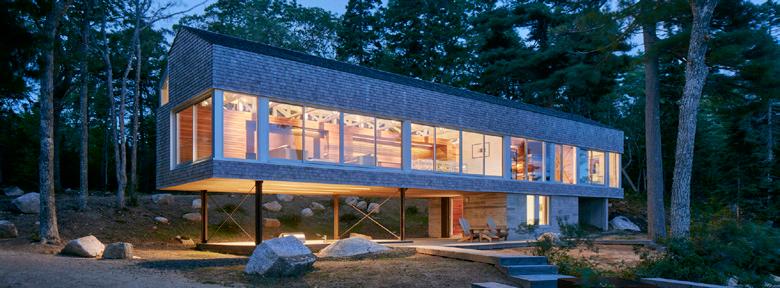
Mirror Point Cottage is committed to place. It is designed with a respect of traditional coastal language and employs a formal inventiveness with common local materials. Materially, this is a “sweet and sour” building, combining highly crafted Western red cedar millwork with economical SPF gang-nail trusses that are common in contemporary North American House construction. Gang-nail wood structural components were used extensively to reduce the amount of structural steel and cost. Normally covered up, these ordinary materials are celebrated in the living and dining space by juxtaposing them against natural cedar millwork and pine shiplap painted white.
The exterior is clad in local Eastern white cedar shingles and a standing seam metal roof. Building on a traditional understanding of local wood construction, different wood species were used based on their natural properties and historical application. The cedar shingles contain natural preservatives and are better suited to the local climate, while the hemlock terrace is naturally rot-resistant. With its inherent high level of environmental sustainability, affordability and a subtly refined aesthetic, Mirror Point exemplifies how the design team builds upon this understated, everyday language of construction.
STRUCTURAL ENGINEER
Campbell Comeau Engineering Ltd.
Halifax, NS
GENERAL CONTRACTOR
Scott Shearer Contracting Ltd.
Windsor, NS
PHOTOGRAPHY
James Brittain
Montreal, QC




Tsuruta Architects
London, UK
The design team’s concept for this conservatory was for it to be an integral part of the garden as well as part of the Grade 2 listed building (buildings of special architectural or historical interest) located in a conservation area of London. Wood was considered the most appropriate material in this context – i.e., where a traditional style is respected but a contemporary approach is encouraged.

The roof profile needed to be a shallow pitch over a deep span so that it sits below the existing adjacent wall that is shared with a neighbor. A well-drained glass roof is essential for any conservatory. Within the given constraints, the design arrived at a combination of short and steep falls with long and shallow falls in a complex diagrid frame. It is easy to make complex joints with wood, which led to the frame and structure being assembled in smaller elements. All pieces are light enough to be carried manually and fixed with traditional carpentry skills on site in a short timeframe.
This was only possible with the help of a simple digital fabrication method, using a CNC milling machine. The architect’s 3D model was sent directly to the CNC milling workshop and processed exactly as planned, forming the correct sizes and angles to achieve the required roof falls. Any discrepancy was easily rectified on site using a conventional woodwork method. All cross junctions of the beams were structurally designed with no need for glue or any mechanical fixings.
The team also benefited from the natural structural capacity and low thermal conductivity of wood. A conventional layered arrangement of a building envelope, the structure, insulation and cladding was simplified
into one solid wood piece to form the entire structure and enclosure with glazing units in four-seasons glass. Although each section needed to be wide and deep, they contribute to the character of the space by casting shadows and emphasizing the presence of natural light.
The wood used is Accoya, known for its dimension stability and durability from water decay over a long lifespan. This acetylated wood was used for most of the components: the structure, window cladding, even as a roof coping. Using the same species also enabled the team to use off-cut pieces between components.
Externally, the wood components were charred, a traditional Japanese way to carbonise the wood surface, protecting it against fungus and rot from water decay while giving an aesthetic advantage. Wood tends to discolor inconsistently, particularly in the rainy London weather; the darkness of the charred finish keeps the appearance of the roof consistent over a long period of time. Internally, the wood surface is oiled so that it breathes, and damaged surfaces are easily repaired locally, extending overall longevity.
STRUCTURAL ENGINEER
Webb Yates Engineers
London, UK
GENERAL CONTRACTOR
JK London Construction Ltd.
Northolt, UK
PHOTOGRAPHY
Ståle Eriksen
London, UK




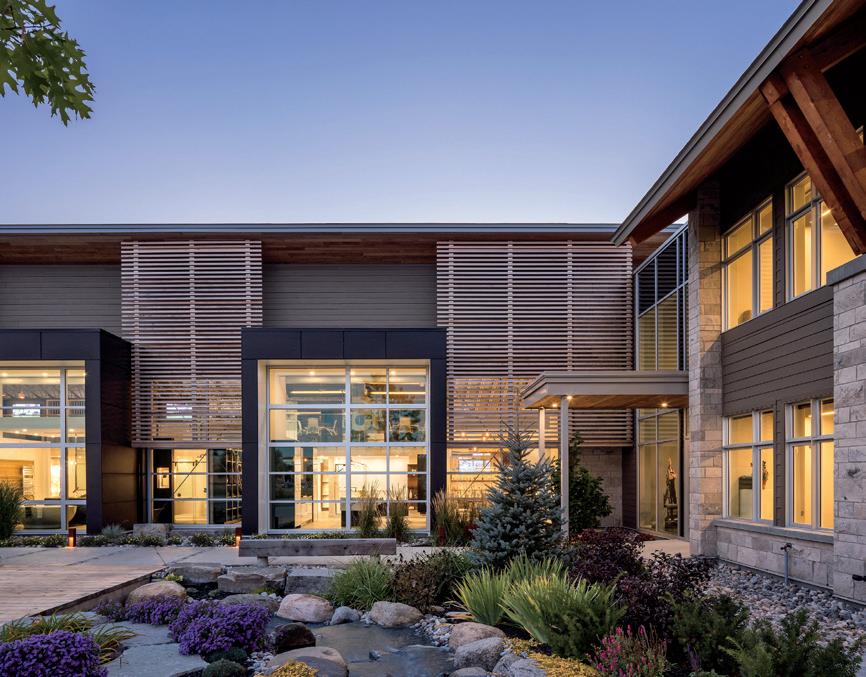





The cover star for this year’s awards, which also represents the international entries, is a project in Turkey that charmed the jurors with its innovative yet unpretentious details and adaptable design. “This was one that we all really fell in love with – we wanted to go stay there,” juror Laura Hartman commented. “I think what is particularly remarkable about it, is everyone tries to make something that’s flexible and operable, that people can modulate to fit the time of day or the time of year, but this really pulls it off. These hydraulically balanced shutters that can lift up and extend the interior space out to the decks, provide sun-shading and protection, are a clever and well-executed solution to giving flexibility in
this relatively small, modest building.”
Conceived as an off-grid modular structure that can be constructed in almost any location, The Modular Unit was designed by the eponymous firm founded by Onur Teke; in 2016, he was selected for the European Architecture Award as the most important, emerging young architect. The same year, one of his first independent projects (T-House, a concrete and wood home) was nominated for the Aga Khan Award for Architecture. Before establishing Teke Architects, he worked as Associate Partner at Renzo Piano Building Workshop (RPBW) for more than 13 years, where he led the design team for the Kimbell Art Museum.
Perched high on a steep Turkish cliff offering stunning views of the Aegean Sea, The Modular Unit (MU50) is a small-scale, off-grid structure designed to be recyclable and adaptable to a wide variety of sites.
The client had conceived the module as a temporary living unit that could be flexible enough to accommodate future needs for a workplace. Through its simplicity, flexibility and choice of materials, this structure is intended to bring beauty to the users’ daily lives by allowing them to incorporate it into their everyday landscape, and
to connect with the surrounding environment with a minimal carbon footprint. A single module consists of two untreated larch timber frames and the enclosure between them. The structure has a simple open plan with a 540-sq.ft. footprint and an additional 430-sq.ft. of exterior decks. The main enclosure is divided into a living and a sleeping area by a service pod, which includes the bathroom, kitchen and necessary storage space. Glazing on all sides of the building allows visual transparency and creates a sense of openness and continuity between the interior and
the surrounding landscape. The exterior decks, protected at different times of the day by manually operated timber shades, offer a variety of micro-climatic outdoor experiences generated by the sun and wind conditions that change as one moves around the unit.
The structural larch wood frames and the enclosure panels were prefabricated and then easily mounted onsite, reducing installation time. Details of the steep gable-roof cover were developed for three possible building materials – wood, aluminum and copper – with copper used to

cover MU50. This is a multilayered, passive climatic control surface; while the thermal insulation and waterproofed panel finish above the laminated wood roof structure provides the function of a conventional system, the copper surface mounted above the actual roof surface provides an efficient passive control and reduction of heat gain by creating continuous air movement and shading above the unit. This roof also houses the photovoltaic and solar panels, making them an integrated component of the design language.
The MU50 is double glazed on all building sides, except for an enclosed structural bay on the south facade that contains all mechanical and electrical equipment; this includes a ground-source heat pump for the custom-designed underfloor heating and cooling system integrated into the timber frame. The glass enclosure helps establish a feeling of openness and connection to the surroundings. Other materials could be chosen as the building skin, however, to match different spatial functions or climatic conditions.
The unit incorporates technology that reduces its environmental impact. A simple, open plan allows natural lighting and facilitates cross-ventilation. The
transparent surfaces designed to receive maximum daylight into the interior spaces minimize the necessity for artificial lighting. A ground-source heat pump and underfloor heating constitute an efficient system that makes use of minimal energy. The floor of the unit is raised above the ground, which allows air circulation below its surface. Building orientation, custom-made double-pane glazing and piston-operated pine sunshades all protect the interior from direct sunlight.
The modular system used to build MU50 was designed to allow a wide range of building uses, reduce environmental impact and maximize site flexibility. The elements of this modular system – structural frame, enclosure, service pod – can be varied in number and materials to house different functions. As more structural frames are added, the building becomes larger; it can remain a singular rectangular space or it can be subdivided by one or more service pods. Thus, a simple act of repeating and combining a small number of relatively simple building elements can produce a wide variety of spaces fit for different uses – from a small meditation room to a dwelling.
As a basic principle, regardless of the
building use or choice of site, the modular system elements are designed to be constructed with reusable and recyclable materials that are easily available and can be assembled by local builders on any specific site. This fundamental design choice ensures reduced environmental impact for any specific building size or use. Simple spatial configurations that result from repetition of the basic elements facilitate natural lighting and ventilation. Water collecting and energy producing systems can be added to the basic units to make them completely off-grid.
The lightness and simplicity of the elements used to build the unit ensure considerable flexibility when choosing a site. Indeed, the hardest part of the project may be deciding where to put it, as the modular unit can be constructed anywhere from a mountain slope in the Alps to a rooftop in New York City.
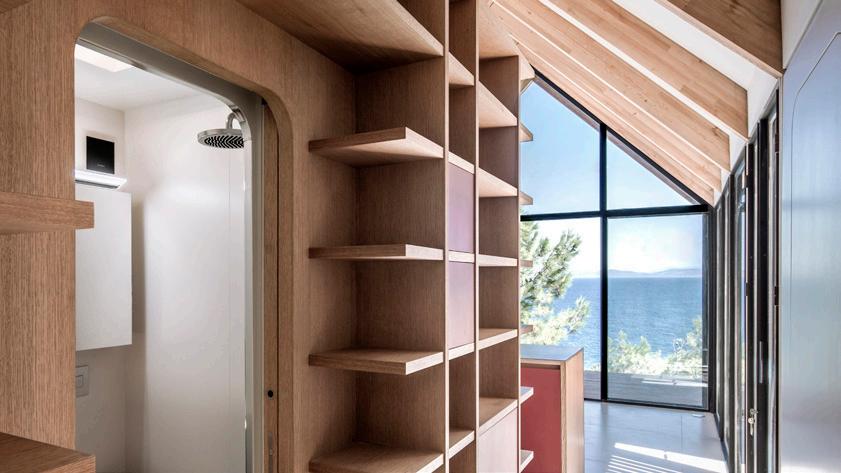

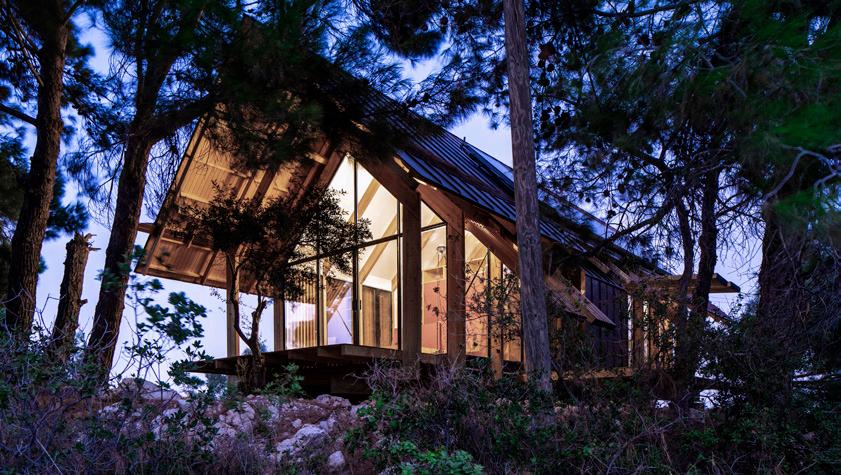
The issue of insufficient, and sometimes unsuitable, housing is one that has plagued Canada’s First Nations for decades. The ongoing housing crisis on reserves is a complex problem beset by environmental, logistical, infrastructure and governance challenges that, despite numerous studies and various initiatives, has yet to be successfully resolved.
Although it is true that housing supply is a concern for all jurisdictions in Canada, the shortage disproportionately affects people living on First Nations reserves. Lawrence Dedam, a resident and spokesperson for the Elsipogtog First Nation in New Brunswick, estimates the need in his community is about 500 homes. “Our community has a peak of 4,000 residents, and we’re in a backlog of maybe 500 homes,” he explains. “Our families are housing other families, friends’ families, in one house.”
The housing shortage isn’t the only concern in Elsipogtog. Mold has become a serious problem, a concern that’s shared by many other communities. Simply put, the homes were not designed for the elevated moisture loads created by overcrowding, and the high humidity levels have led to the growth of black mold – an outcome that has serious health implications. But mold growth doesn’t only occur in overcrowded homes; it also occurs when moisture from any source is not properly managed, and
inadequate moisture management is a common problem in poorly designed and poorly constructed homes. For homes in the north, thermal bridging of the building envelope is a critical concern. Condensation resulting from cold spots in the exterior walls creates the perfect environment for mold growth.
In a recent interview about Cardinal House, renowned Indigenous architect Douglas Cardinal described a meeting he had with community Elders who asked him to design a better house for their people. “They brought me into a standard house that was stick-built with drywall and they said, ‘These houses do not work for us at all. Mold is creating real health problems for our children. We can’t continue to build unhealthy houses and raise our children in them – it’s not right. We want you to design a healthy, long-lasting house that we can pass on to our grandchildren.’”
Committed to developing a real solution, Cardinal – along with a skilled team of construction professionals – designed, prefabricated and assembled the first Cardinal House, a prototype that was completed in October for the Elsipogtog First Nation in New Brunswick.
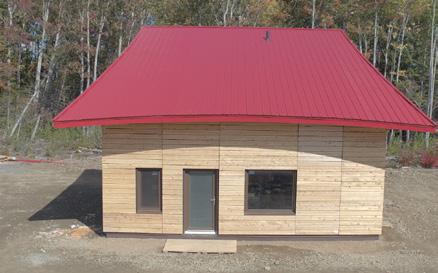
The 1,100-sq.ft. two-storey, three-bedroom/two-bathroom Cardinal House is a high-performance, mold-resistant mass timber design. Manufactured offsite to exacting standards in a controlled indoor environment, then shipped on a single truck and assembled by a small crew in just a few days, Cardinal House is an affordable solution that uses modern materials and methods to successfully address many of the key issues contributing to the housing crisis.
Idoya Arana-Beobide, managing director of Douglas Cardinal Architect, explained why wood was the natural solution for this project: “Douglas Cardinal’s vision was to create a healthy, beautiful, lasting home for the Indigenous peoples. He, guided by the Elders, wanted to have a house that was all wood, because wood is the only renewable building material that we have. Wood is a live material; when you are around wood, you feel good, you feel nurtured.”
The factory-built house uses innovative wall panels called CLIPs (cross-laminated insulated panels) for the building envelope. The CLIPs are fabricated with the insulation preinstalled in the plant, a design strategy that eliminates thermal
bridging and the mold-causing condensation that can come along with it. CLIPs are a cost-efficient composite building element fabricated with CLT and other products for use in commercial, multi-unit residential and single-family applications; they are highly customizable and can be manufactured to varying degrees of completion (e.g. siding preinstalled or site-installed), with different insulation types and varied performance characteristics depending on project requirements. CLIPs also enable rapid construction and can be prefabricated to Passive House
standard, as finished exterior walls that include insulation, windows, doors and exterior cladding. The CLIPs used for the exterior walls of the Cardinal House have Type II EPS insulation and a thermal performance of R-28; the roof cassettes are insulated with cellulose, composed of up to 85 percent recycled newspaper, and have an R-value in excess of R-60.

Energy efficient, triple-glazed windows were preinstalled into the CLIPs in the factory and contribute to the superior thermal performance of the building envelope. The windows are Passive House
certified and have an installed U-value of 0.81 W/m 2K. The home’s airtight envelope – the blower door test achieved confirmed airtightness of 1.2 ACH (air changes per hour) at 50 Pa – minimizes heat transfer through air infiltration/ leaks.
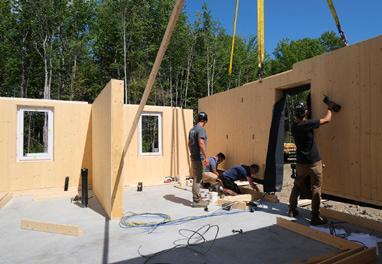
The insulated slab on grade serves multiple purposes as foundation, radiant heating system and finished floor (with epoxy coating); it also minimizes heat loss and reduce excavation costs along with the amount of concrete needed for the foundation.


According to Adrienne Fainman, who was the Cardinal House project manager and is an architectural designer at Douglas Cardinal Architect, CLT construction offers an excellent housing solution for challenging environments. “The communities across the north are the most susceptible to climate change – they have harsh climates that are getting harsher, so the building technology needs to address that. The Cardinal House addresses issues that are problematic in housing across the country: durability and longevity. Most houses last one generation; this is designed to last many.
“We’ve created a healthy, breathable living environment, eliminated mold and
vastly increased the fire safety of the house. Using engineered heavy timber products like CLT allows us to deliver quality housing to remote locations because we can do so much prefabrication in the shop. We save a lot of costs on labour and transportation.”
The housing needs across the country are as diverse as the First Nations communities affected by the crisis, so there is no single solution. Many infrastructure and governance challenges also need to be addressed for all First Nations communities to have enough healthy, suitable housing for all residents. However, the prototype Cardinal House offers an affordable and repeatable solution that addresses the central concerns of the homes themselves, and delivers a mold-free, energy-efficient home designed to last for generations.
The Department of Aboriginal Affairs and Northern Development Canada (now Indigenous Services Canada) issued a report1 in March 2012 estimating that 130,197 new housing units would need to be built on reserves before 2031 to accommodate household and family growth; an additional 11,855 units would be needed to replace existing, deteriorated stock, and major renovations would be needed for up to 10,861 existing homes.
Almost one quarter (24.2 percent) of First Nations people reported living in a dwelling in need of major repairs, 2 compared to the rest of Canada at only six percent.
According to a report by Statistics Canada, “Census in Brief: The housing conditions of Aboriginal people in
ARCHITECT
Douglas Cardinal Architect
Ottawa, ON
STRUCTURAL ENGINEERS
Aspect Structural Engineers
Toronto, ON
GENERAL CONTRACTORS
Maisons Chicoine Homes
(site assembly)
Alcove, QC
Element5 Co. (off-site prefabrication)
Ripon, QC
PHOTOGRAPHY
Mark Hemmings
Saint John, NB
Canada” (2017), 36.8 percent of people on a reserve live in a crowded3 dwelling, a number that remained virtually unchanged from 2011 to 2016.
Crowded dwellings can cause issues with mold (a common problem in First Nations communities); according to a study by the Standing Senate Committee on Aboriginal Peoples, the results of which were published in a 2015 report,4 the mold problem can be linked, at least partially, to the housing shortage itself: “There is a significant housing shortage on reserves across Canada, that has led to high levels of overcrowding; much of the existing housing stock is poorly built and in serious disrepair, with many communities experiencing problems with mold which is exacerbated by the problem of overcrowding.”
3. A crowded house is one that is not considered suitable for the number of people who live there according
Standard (CNOS) assesses the bedroom requirements of a household based on the following criteria:
• There should be no more than two persons per bedroom;
• Children less than 5 years of age of different sexes may reasonably share a bedroom;
• Children 5 years of age or older of opposite sex should have separate bedrooms;
• Children less than 18 years of age and of the same sex may reasonably share a bedroom; and
• Single household members 18 years or older should have a separate bedroom, as should parents or couples.

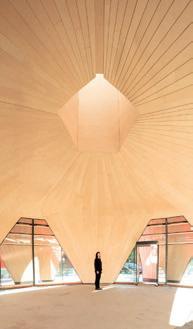


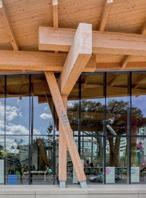



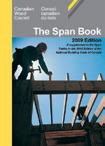




In the world of architecture, many “wood champions” have made bold choices to elevate the use of this beautiful, renewable building material – but several firms consistently attract international acclaim, for both design excellence and innovation. These architects are helping the world to see wood in a new light.
Founded in 2009, this relatively young company already has joined the leaders of mass timber construction. The 16,000-sq.ft. mid-rise Albina Yard office building, completed in 2016, was the first U.S. building made from domestically produced CLT (manufactured in Oregon); it won several awards. In the 2019 Wood Design & Building Awards, the firm earned a Citation Award for Redfox Commons, a 60,000-sq.ft. renovation that used the site’s original timber beams from structures built in the 1940s to create a modern office compound. Unfortunately, Lever’s ambitious 12-storey CLT tower, Framework – which would have been the first all-wood high-rise in the U.S. – is on hold (due to financing issues) even after winning the $1.5-million Tall Wood Building Prize for research and development; the good news is, the building permit was approved by the State of Oregon and City of Portland, setting a new precedent for mass timber high-rises.


Established in the late 1970s, this husband-and-wife firm consistently produces award-winning projects that showcase the versatility and beauty of wood. The angular Hadaway House claimed an Award of Excellence from Canadian Architect , and the Audain Art Museum in Whistler, B.C., was recognized with a 2018 AIA Award and RIBA Award for International Excellence. More recently, the Capilano Library in Edmonton garnered a Merit Award in the 2019
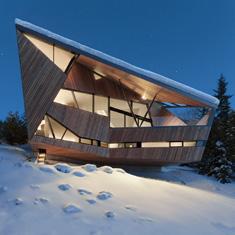
Wood Design & Building Awards, and the ethereal Yasodhara Ashram Temple of Light won a Wood Innovation Award from B.C. Wood WORKS! In collaboration with MacLennan Jaunkalns Miller Architects, Patkau is currently planning the 15-storey Academic Wood Tower for the University of Toronto, which could become North America’s tallest timber building, with glulam floor decks, core, beams and perimeter bracing; completion is anticipated in 2022.
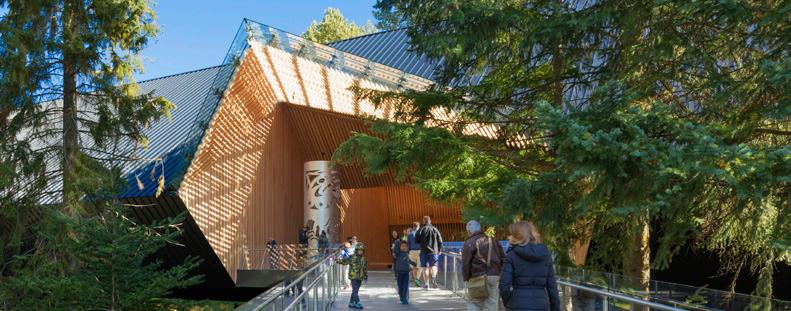

While developing its best-known project, Carbon 12, Kaiser Group and Path Architecture worked with city and state officials to waive restrictive codes limiting the height of wood buildings; at eight storeys, Carbon 12 became the tallest CLT building in the U.S. when it was completed in 2018. An earlier project (completed in 2014), Radiator was the first all-timber building of its scale in the past century, with five storeys comprising 38,000 sq.ft. The firm is now in the design and research phase for The Spar, which aspires to become the tallest mass timber building in the world, with 36 storeys and almost 600,000 sq.ft. of office and commercial space.

Innovation does not need to be on a large scale; in the case of this award-winning firm, established in 2011, its fame was secured by the design of the Grotto Sauna, an 800-sq.ft. project for a private client. With an exterior of charred cedar using the traditional Shou Sugi Ban method and interior panels reclaimed from local forests being cleared for development, the structure was prefabricated on a nearby island before being boated and craned into place. Digital design enabled minimal site excavation, while the use of CNC machinery allowed for precise execution of the concept. A similar aesthetic was implemented for Bar Raval in Toronto, a renovation that transformed a rundown commercial space into a stunning tavern for tapas and cocktails, inspired by Spanish Art Nouveau design; more than five miles of engravings shape 75 undulating mahogany panels that encase the interior. Currently under construction, the firm’s Hill Spring House incorporates compression-bent wood paneling and a cedar-clad exterior, while its Caledon Follies residential project will also showcase wood throughout the interior.

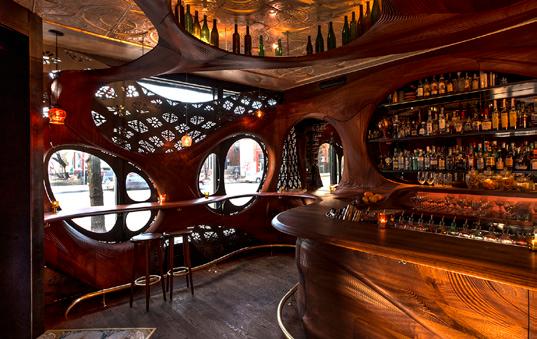

A frequent Wood Design & Building Award winner (including 2019 Merit Awards for two residential projects: Kiht’han and Sagg Farm), this firm has received close to 200 design awards since 2003. Georgica Cove, a 6,500-sq.ft. residential project, won a 2019 AIA Housing Award and many other accolades, including a Wood Design & Building Award in 2017 (Honor). This year’s Merit Award winners were both notable for their exceptional attention to detail and elegant execution – traits which the firm consistently displays in all of its designs. A dedication to using wood appears in almost every project, from exteriors to interiors. Notably, in the late 1960s and early 1970s, most of architect Harry Bates’ first structures were predominantly built of wood.
Founded in 1984, last year this awardwinning firm was voted the best in the U.S. by Architect magazine. Among more than 300 design awards in total, Lake|Flato received the AIA Firm of the Year Award in 2004 and received the Global Award for Sustainable Architecture in 2013. Blue Lake Retreat, a three-storey residential project, won the 2017 AIA National Housing Award. One of the company’s most acclaimed recent projects, the Marine Education Center in Mississippi, won a 2018 Wood Design & Building Award (Honor). Garnering a 2018 AIA San Antonio Merit Award, the Clinton Corners Residence is constructed of heavy timber framing and superinsulated, prefabricated panels. The firm is now completing the six-storey Soto, the first mass timber office building in Texas, and a 23,000-sq.ft. mass timber structure for the University of Denver, targeting LEED Platinum and due for completion this

In 2012, after leaving McFarlane Green Biggar (winner of multiple wood awards), Michael Green’s eponymous firm quickly became known as a leader in mass timber architecture. His 2013 TED Talk, “Why we should build wooden skyscrapers,” has since passed 1,350,000 views. The firm is most recently involved in the high-profile Sidewalk Toronto proposal, for which MGA is designing an innovative protomodel toolkit to create a mass-timber mixed-use neighborhood. Possibly the firm’s most famous project, T3 Minneapolis, was the first U.S. timber building in a century and the largest in North America at the time of completion (2016). The seven-storey, 220,000-sq.ft. structure was completed in under three months, using enough wood to sequester about
3,200 tonnes of carbon. The majority of more than 1,100 NLT panels used for the project were made from trees killed by the mountain pine beetle. Another project that was the largest modern mass timber building in the world when it was built, The Wood Innovation Design Centre (in Prince George, B.C.) is an eight-storey educational facility with mass timber walls, systems-integrated CLT floor panels and glulam columns and beams. In 2016, it was one of two MGA projects to win the Governor General’s Medal in Architecture; the other, Ronald McDonald House of B.C., features an innovative tilt-up CLT wood structure. In collaboration with Game Creek Holdings, MGA is currently developing the 32-unit, 29,300sq.ft. Honeycomb Housing Prototype in

Austin, Texas, based on a prefabricated, mass timber kit of parts intended to be a solution for urban infill sites. Other upcoming projects include Oregon State University’s College of Forestry (two new buildings totaling 100,000 sq.ft.) and Riverfront Square, a 12-acre, 2,000-unit residential project in Newark, New Jersey, which will include an 11-storey timber building. Due for completion early this year, the firm is also constructing Washington State’s first CLT office building, the 150,000-sq.ft. Catalyst project, supplied by Katerra’s new $150-million CLT factory in Spokane; in 2018, MGA was acquired by Katerra, a California-based construction innovator that specializes in automated production and modular components.

A Pritzker Prize laureate who also was named “Innovator of the Year” by Time Magazine in 2001, Shigeru Ban is internationally known as one of the world’s masters of wood. The Aspen Art Museum, winner of a 2017 AIA Honor Award, features a distinctive woven facade made of a wood veneer composite; the roof trusses are also a striking feature, with large wood beams and curved members that visually merge into a dynamic pattern. Other recent projects reflect similar artistry, and many of the firm’s projects highlight the versatility and dramatic beauty of wood. The Shonai Hotel Suiden Terrasse won a 2018 Wood Design & Building Award (Merit), and the Mt. Fuji World Heritage Center was recognized with several design awards. Completed last year, the predominantly wood Shishi-Iwa House is a 10-room boutique resort in Japan that was designed to conserve as many existing trees as possible, with a curvilinear form; it was created using modular elements, with prefabricated plywood panels and timber framing. The dramatic Swatch and Omega Campus was also completed last year in Biel/Bienne, Switzerland – a town known for its timber engineering school, and also where the structural prototype for Shigeru Ban’s Centre Pompidou Metz was developed. Currently under construction, The Terrace House in Vancouver will be the world’s tallest hybrid timber structure, with 19 storeys. Ban is also developing Kentucky Owl Park in Bardstown, Kentucky; the 420-acre site will feature a state-of-the-art whiskey distillery, bottling center and offices – again, with wood playing a starring role.

Established in 1995, this company was shortlisted twice before winning the Stirling Prize in 2017 for Hastings Pier, the restoration and redesign of a centuryold wooden pier which was commended as a “masterpiece of regeneration and inspiration.” A visitor center on deck is clad in salvaged wooden boards, and the pier’s unpretentious, open design provides optimal public space that can accommodate performances and large gatherings. Several other recent projects showcase the firm’s expertise in working with wood: Maggie’s Oldham is a cancer recovery center constructed of American tulipwood CLT, also clad with tulipwood; thin strips of timber line the ceilings, and other tactile wood surfaces (such as oak rather than metal doorknobs) are incorporated to provide natural warmth and comfort to patients. WoodBlock House is a three-storey CLT structure clad with

larch boards and colorfully painted plywood in the artist-owner’s trademark style. Timber lines the walls, floors and ceilings of the two residential floors; the ground floor is the artist’s workshop. Another art studio, the Comet Street project, is a smaller but distinctive struc-
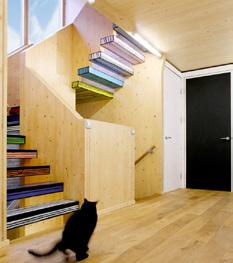
ture also built of CLT, with exterior walls clad in zinc panels. The studio is currently initiating several new mass timber projects, including residential, educational and office structures that will likely reinforce dRMM’s leading role as an advocate for wood architecture.
When this firm completed the nine-storey Murray Grove building in 2009, it joined the forerunners of mass timber; this was the world’s first multi-storey building to have load-bearing walls, floor slabs, stairs and lift cores constructed entirely of timber. In 2017, the 121-unit, 155,000-sq.ft. Dalston Works residential project became the world’s largest all-CLT building, although disguised behind a brick facade; it weighs a fifth of a concrete building the same size, which allowed for greater capacity (25 percent more units) and height (up to 10 storeys in some sections). Currently under construction, the six-storey 6 Orsman Road office building in London is a hybrid steel and timber structure with CLT core, internal walls and floor slabs, supported by steel framing (similar to Curtain Place, which was built in 2015). Another upcom-
ing project, Watts Grove, is a groundbreaking modular CLT mid-rise that will provide 65 affordable homes in a car-free setting with pedestrian pathways and courtyards. In an exciting development, the firm also recently started working in collaboration with Gray Organschi Architecture (winner of two 2018 Wood Design & Building Awards, and many other accolades). Both firms now work together as WT/GO Architecture, based out of New Haven, Connecticut, and are among six other firms – including Shigeru Ban, Dorte Mandrup and Lever Architecture – invited to submit design proposals for a $16-million, five-storey timber design and fabrication lab at the University of Arkansas; the designer will be chosen this spring, with project completion by the end of 2022.





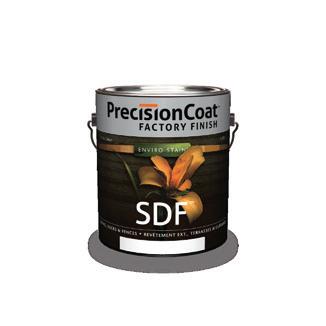
Too often, building maintenance – especially where the coating is concerned – is not a consideration during the design phase of a project. But there are many reasons why maintenance of the coating on a wood structure should be considered early in the process. In fact, starting with maintenance in mind will help ensure the
enduring beauty and protection of a wood structure that keeps it looking as good as it did on d ay one.
Sjoerd Bos, Managing Director of Sansin Corporation, has been involved in the maintenance of large, wood commercial structures throughout Europe and North America for the past three
decades. As a result, he has fielded many questions regarding maintenance expectations. Mr. Bos believes that the building owner is best served when the right questions are asked to ensure the expectations for wood maintenance are realistic and in line with the exposure, wood type and other factors.

Q: Why should architects and builders consider maintenance
A: As the use of wood grows, there is increasing expectation of performance over time. It is not enough for the building to just look good at the grand opening. This is why we always counsel architects and builders to develop a coating system with maintenance in mind. Certainly, beauty is one aspect of the project, but how the wood substrates will perform are contingent on exposure to UV and moisture, the color of the finish, the design of the building and the quality of the wood, to name a few. Our goal is to support the architect’s vision of the building design, but also offer advice around how design decisions impact durability and ease of maintenance.
Q: How does one budget
when selecting an architectural finish? for maintenance?
A: We recommend that the budget for maintenance be part of the specification and accounted for in the design phase. We have seen a trend – especially in Europe – where a maintenance schedule and budget will be decided upon before the building is inhabited. For example, a very large commercial cedar building was erected in Northern Europe that used Sansin SDF on the exterior; this building included a 30-year maintenance program in which our SDF product would be applied at an agreed-upon interval that ensured the maintenance coat was applied proactively.
Q: What should designers consider when selecting a coating product to extend the maintenance cycle?
A: The goal is to find a suitable wood finish. Water-borne finishes – those that penetrate the wood rather than sitting on top of it – enable the product and pigment to penetrate into the wood fiber. Also, one should consider a finish that doesn’t alter the transparency when maintained.
One must often balance durability with the desire for lasting natural aesthetics. Often to achieve a desired look, the coating may require special treatments so that the appearance is balanced with strong enough UV protection to extend the maintenance cycle. Not surprisingly, less transparent or darker colors are going to offer a longer maintenance cycle than a one-coat, clear system.
Additionally, we recommend undercoats, especially for large buildings, as a way to protect wood in transit from the factory and at the construction site. One never knows what might hold up construction, and an undercoat will protect the wood from UV degradation and water absorption especially at the end grain. Our water-borne undercoats are also recoatable, which is conducive to more uniform top-coating and easier maintenance.
Q: How are coating decisions different for different types of wood (eg. engineered wood products versus Western Red Cedar?)
A: Different wood species have different innate characteristics that impact coating decisions. Some, like maple, are

naturally light while others have large knots. Some, like cedar, have contrasting colors because of variations in sapwood and hardwood. Ipe has an inherently darker color. Some modified woods require more protection than others. This is why, when we work with architects, our first question is about the wood species that will be used on the project. In many cases, a specific wood product may not be suitable for the exposure. When given the opportunity, Sansin can offer advice.
Q: What are best practices for ensuring quality control during application?
A: First, for large projects, we strongly recommend that at least the first one or two coats of product be applied in a factory-controlled setting – or in a setting that can attain a certain level of temperature and humidity control. Ambient air temperatures have a significant impact on drying time and proper curing.
Further, it goes without saying – but we often have to reinforce this point – the product must be applied in accordance with published preparation and application procedures as stated in the product data sheets. All manufacturers should provide these documents to guide application.
Other best practices for a longer maintenance interval are to apply product to all six sides of a properly sanded and prepared wood surface, and then applying the proper dosage of product, achieving what we call the “recommended mil thickness” for each coat. This mil thickness should be recorded and kept on file for any warranty considerations, along with a control sample. Sanding, correct dosage, even application of the product to all sides, and proper drying and storage are the fundamentals of wood finishing for long-term success.
On the job site, if the wood has been damaged in transit, the contractor should take the necessary steps to repair the damage and reapply the coating. Any ends cut on the jobsite must be coated, as the unsealed end grain is most susceptible to moisture intrusion.

Q: What are the biggest application mistakes builders make that impact maintenance cycles?
A: Builders need to be concerned about the care of the wood at the building site. That means no contact with wet soil, wraps that don’t allow water to get inside and pool, and being careful about moving the wood around on the construction site to prevent damage. In short, you want to limit the wear and tear on the wood at the building site. That’s why we recommend that at least an undercoat be applied – preferably in a factorycontrolled setting – before the wood gets to the site.
Additionally, preparation is key. Often, wood needs to be sanded to open the pores so that the finish penetrates into the wood evenly. Some may want to take shortcuts on sanding, but this can be costly for the building owner. Sanding right before the first coat, especially, is the critical first step to ensure the finish goes on consistently, penetrates well and helps ensure overall success of the project. Using proper equipment to sand evenly at the right grit is imperative to quality and productivity.
Q: What is the expected longevity of coating performance, and what are the contributing factors?
A: There are many factors that contribute to the longevity of a coating. Durability and maintenance cycles are impacted by wood quality, exposure and condition, surface preparation, workmanship, storage conditions and design or landscaping, to name just a few.
Q: Understanding that maintenance is part of the life cycle of the wood finish, when and how often should maintenance be conducted for optimum performance and color retention? Are there any special steps for prepping the surface for maintenance versus prepping it for initial coating?
A: When approaching the expected maintenance time, we recommend examining the surface every six months to check on the coating, because proactively identifying areas that require attention is key to easy maintenance. Also, wood features often do not wear evenly. Different sides of a building could be exposed to different elements that can impact the coating performance. For instance, a side that is exposed to sea air or an inordinate amount of sun may need more frequent maintenance than a side that is shaded. You want to catch worn areas early so you can simply wash and apply a protective top coat to safeguard a more vulnerable area. If you let it go past the point of maintenance and the wear gets through to exposed wood, the maintenance process will be more arduous.
About Sansin: For over 30 years, Sansin has been the only wood protection company focused exclusively on researching and developing environmentally friendly, waterborne interior and exterior wood products and technologies that deliver outstanding color, durability and performance without the toxicity found in conventional stains. Sansin wood treatments, finishes and preservatives use water, not petroleum solvents, to deeply penetrate and protect wood naturally, from within.
* Nova Scotia Non-Residential Award *
* New Brunswick Non-Residential Award *
* Prince Edward Island Non-Residential Award *
* Newfoundland & Labrador Non-Residential Award *
* Atlantic Hybrid Award *
* Atlantic Multi-Unit Residential Award *
* Atlantic Residential Award *
* Atlantic Engineer Award *
* Atlantic Architect Award *
* Wood Champion Award *
* Jury’s Choice Award *



The first question you might ask about Foon Skis is, “Why ‘Foon’?” That’s the nickname of founder and lead craftsman Johnny “Foon” Chilton. Since 2011, Johnny and his team in Pemberton, B.C., have handcrafted their custom skis from locally sourced Coast Mountain yellow cedar and Western big leaf maple.
Sustainability is an integral factor to everything that Foon Skis does. Part of how the company measures success is by lowering its environmental impact, so they’re constantly evaluating the
materials used to make the skis (from locally sourced solid wood, if you please; no glued strips here), while doing everything they can to reduce their manufacturing footprint. The company also donates one percent of all sales to environmental charities.

Foon Skis even promises that all the wood offcuts they generate are used to heat Johnny’s house through the winter – something that should make everyone feel a little warmer inside.
foonskis.com
MANUFACTURERS of LAMINATED TIMBERS and WOOD TRUSSES

Rigidply Rafters Inc. Engineers and manufacturing capabilities can help turn your vision into reality. Let the natural beauty of wood - Glue-Laminated Timbers - bring the performance, stability, and charm to your project.

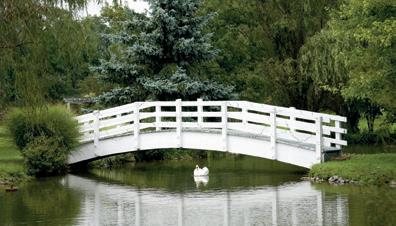


www.rigidply.com
701 E. Linden Street, Richland PA 17087 717.866.6580
1283 Joni Miller Road, Oakland MD 21550 301.334.3977

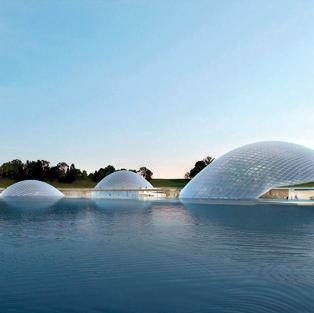


From mass timber to custom architectural timber structures, we collaborate with today’s leading architects and owners to engineer-build exposed timber structures that are efficient and elegant in both design and construction detail.
